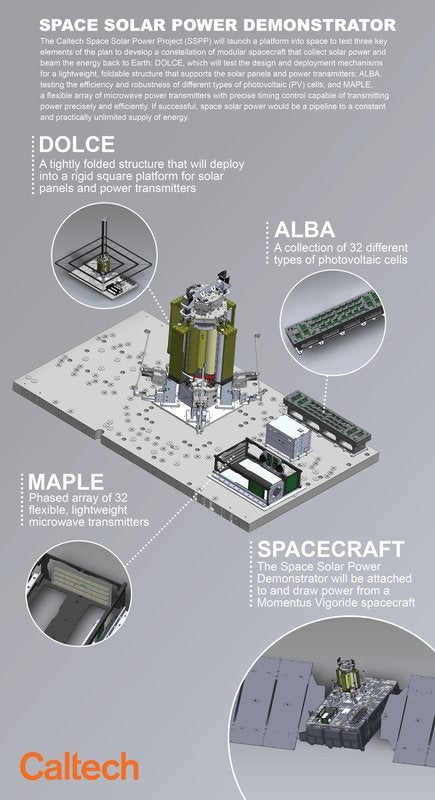Space-based solar power could provide round-the-clock access to renewable energy, sidestepping one of the technology’s biggest limitations. Now the idea is going to get its first true test after a Falcon 9 rocket successfully launched experimental hardware designed to assess its feasibility.
The idea of stationing gigantic solar panels in orbit around Earth and beaming the power back has been around for decades. The possibility is attractive, because in space you’re no longer at the mercy of the weather or the planet’s cycles of day and night, and solar radiation levels are higher as sunlight has not had to pass through the atmosphere.
So far though, space-based solar power has remained in the realm of sci-fi due to the technical complexity and unforgiving economics of space technologies. But thanks to a $100 million donation in 2013, a multidisciplinary team from Caltech has been quietly working on it over the past decade, developing the various technologies required to make it a reality. And this past Tuesday, prototypes of some of the key subsystems required for a full-scale space-based solar power plant were delivered into orbit by SpaceX for testing.
Over the next few months, the team behind the Caltech Space Solar Power Project will test out the systems that will allow their flexible solar panels to unfurl in space and the technology designed to transmit power back to Earth. They will also assess how well different kinds of solar panel technologies hold up in the harsh environment of space.
“No matter what happens, this prototype is a major step forward,” Ali Hajimiri, one of the three Caltech professors leading the project, said in a statement. “It works here on Earth, and has passed the rigorous steps required of anything launched into space. There are still many risks, but having gone through the whole process has taught us valuable lessons.”
Building solar panels in space is a much more complicated business than doing so on Earth. The biggest challenge is getting them there in the first place, which is limited by the incredible cost of launching material into orbit. As a result, the team has had to focus on reducing the weight of their solar panels as much as possible without sacrificing their generating capacity.
Their solution combines ultra-thin flexible solar panels, an ingenious design that integrates power generation and transmission, and a novel modular architecture that makes it possible to combine many smaller, self-contained panels to create large arrays.
The basic unit of their design is a rectangular tile a few inches across whose surface is covered in mirror-like solar concentrators that direct sunlight to a strip of photovoltaic cells, where it’s converted into electricity. Beneath the surface is an integrated circuit that converts the power from the solar cells into microwaves, which are then transmitted out of the bottom of the tile by an array of ultra-thin and flexible patch antennas.

This design generates significant weight savings, because it removes the need for bulky wiring to transport the generated electricity to a central transmitter. These tiles will then be arranged into strips and integrated into a novel folding structure that will be compact at launch and then unfurl once in space.
The result will be a self-contained spacecraft that is able to deploy itself, generate power, and transmit it back to Earth, but the vision involves combining many of these to create arrays able to produce comparable amounts of energy to a land-based system. That setup makes it easy to adjust the size and configuration of arrays, and also means that damage to individual modules won’t put the entire system out of action.
The experiments launched this week are designed to test several of the key underlying technologies behind this architecture. One called DOLCE (Deployable on-Orbit ultraLight Composite Experiment) will test out the unfurling mechanism by deploying a six-by-six-foot frame from a small trash-bin-sized canister.
Another called MAPLE (Microwave Array for Power-transfer Low-orbit Experiment) will test out an array of ultralight microwave transmitters designed to beam power over a distance in space. A final experiment called ALBA will put 32 different types of photovoltaic cells through their paces over several months to see which operates most effectively in the punishing environment of space.
Assuming all of the tests go according to plan, the researchers will have validated some of the key technologies required to make their vision a reality. But given the dropping price of solar power on Earth and the growing prevalence of energy storage technologies designed to deal with solar power’s intermittency, there are question marks over the economics and practicality of the idea.
The technology could play an important role in the longer run, though, John Timmer writes in Ars Technica. Most estimates suggest that we should be able to switch around 70 percent of our grid to renewable energy fairly easily, but the lack of reliability due to seasonal changes or rare weather events mean that going higher could be tough.
A source of renewable energy that’s available 24 hours a day, 7 days a week could help to plug the gap when conditions on Earth lead to a drop in generation. We are likely still decades away from needing that, but given how complex space-based solar power is, getting to work on the technology now seems like a smart bet.
Image Credit: Caltech


